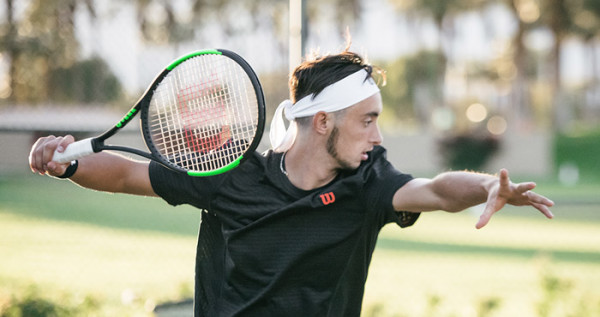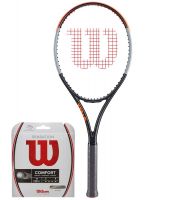Choosing the right tennis racket is certainly the first decision you'll face when you decide to start your tennis adventure. Whether you're buying your first racket or upgrading it later, it might seem difficult to choose. So, to make this process a little easier, I'll show you the overall characteristics of the racket and the impact of individual parameters on the game performance.
Choosing the right racket only at first glance looks extremely complicated. The five most important things you need to know at the very beginning of your tennis adventure are:
- weight,
- head surface area,
- balance,
- used materials,
- grip size.
Next, you should take into consideration parameters such as:
- frame stiffness,
- swingweight.
Tennis racket weight
When it comes to the weight of the rackets designed for adults – they range between 230-340 grams. This parameter is primarily responsible for stability. For a beginner, the racket should be lightweight to make it easier to manoeuvre and to develop proper technique. Lightweight equipment means also lesser chance of overloading your hand.
Beginning male players should aim for rackets weighing 270-285 grams. For women even lighter- preferably between 260-270 grams. As the weight increases, the frame stability will rise, so if you enter the intermediate level, 280-300 gram rackets will become suitable, and as an advanced player you may be tempted to use rackets over 300 grams.
Head size of the tennis racket
The force in the racket is generated mainly from its head, therefore, on the beginning its surface area should be large. 100 square inches (645 square centimetres) is the minimum, but the enlarged head would be the best – 102 square inches (660 square centimetres) or 105 square inches (675 square centimetres).
Larger head means more power, most importantly, larger area of ideal impact (forgiving more mistakes). With growing experience, 100 square inches rackets and smaller will be more suitable due to the ball feel and control.
Used materials
The most sensitive issue for the beginners, mainly because it has the highest impact on price. With higher production quality comes higher equipment cost, and it is not a phenomenon that only occurs in tennis. Rackets may be made of:
- aluminium,
- graphite composite,
- graphite.
The first option is the least beneficial unless you treat tennis as one- time activity. Aluminium rackets are perishable and put a lot of stress on your hand. Prolonged use of aluminium rackets may lead to an injury that will exclude you from playing tennis.
Tennis rackets made of graphite composite are in between – part of them is made of aluminium, but key elements are made of graphite which has better properties. They are cheaper than fully graphite rackets.
Graphite rackets are a guarantee of much greater strength, control, comfort of the game and, what’s perhaps the most important, health. Graphite rackets are the most expensive, but worth investing in, with certainty that they won’t have a negative impact on our health. The latest graphite racket models promoted by leading players often receive new technologies to improve them.
Check out the newest graphite rackets. Previous models of the same rackets may be bought on sales in much lower prices. Check out current sales of graphite rackets.
Grip size
Knowledge about this is important, regardless of what level you are, and many people unwittingly omit this aspect. A properly selected grip is not only a reduced risk of hand injury, but also the comfort of the grip and feel of the racket. The old and proven rule is that the correct grip is one in which the index finger of the other hand fits between the thenar eminence of the thumb and the finger of the player's longest finger.
Grabbing the racket with a playing hand, preferably with a forehand grip and clenching your hand on the grip, a gap will form between the tip of your fingers and your hand. We put the index finger of the other hand in it. If it fits there, the size of the grip is good. If there is a lot of space – the size is too large. If your finger doesn't fit, the size is too small.
The size of the grip takes into account only the size of the hand, without players height. You may find information on how to choose the right size of the grip in our article: "Tennis racket grip size - how to measure?"
Racket frame stiffness
Stiffness tells us about the extent of deformation of the frame when it comes in contact with a ball. This parameter is expressed in RA units. Stiffer rackets allow for a stronger impact, but on the other hand, more vibrations are transmitted to the wrist, elbow and arm.
Flexible rackets give more control over the ball and less stress on the wrist. We may distinguish three groups of rackets depending on flexibility:
- elastic frames (<60 RA),
- medium-flexible frames (60-69 RA),
- stiff frames (>70 RA).
Tennis racket balance
Otherwise known as balance, it specifies the spot, where the racket centre of mass is located. It is specified in millimetres (mm) or centimetres (cm) and is measured from the grip to the centre of mass.
The balance is considered to be located on the grip (HL- Head Light) when this distance is up to 325 mm, it is neutral when this distance is between 325-335 (E – Even), and if it is above 335 mm, the racket is considered to be balanced on the head.
The balance shifted towards the head (HH- Head Heavy) allows player to generate more impact force. Centre of mass shifted towards the grip makes it easier to manoeuvre and control the racket. Beginners (with short swing) are recommended to use rackets with neutral balance, or with the balance slightly moved towards the head to give strikes more dynamics. It is important to notice that balance is specified for rackets with no strings- for rackets with strings the centre of mass will move about 10mm towards the head.
Swingweight
It’s a real feeling of rackets weight at the time of swing and impact. This parameter consists of the resultant mass and its distribution on the racket, balance and aerodynamics of the frame (which is impacted by the thickness, shape and size of the head). The higher the index the higher the inertia and the harder it is to manoeuvre with the racket, but it will generate more power (due to the higher speed).
If you want to talk with our tennis racket specialists, please contact us via the chat at the bottom of the page or by phone number +48 22 823-37-48.
We offer the possibility of testing multiple tennis rackets. To do so, please visit one of our stores located in Warsaw.












